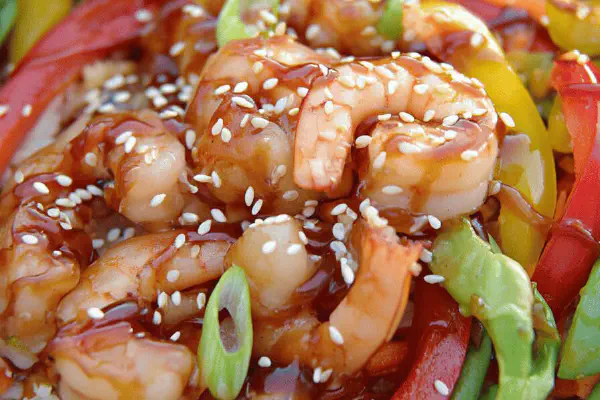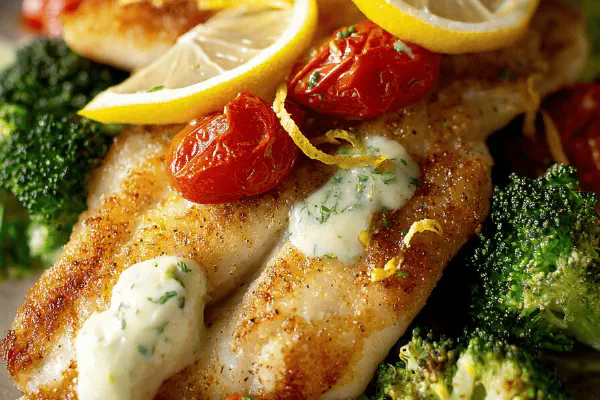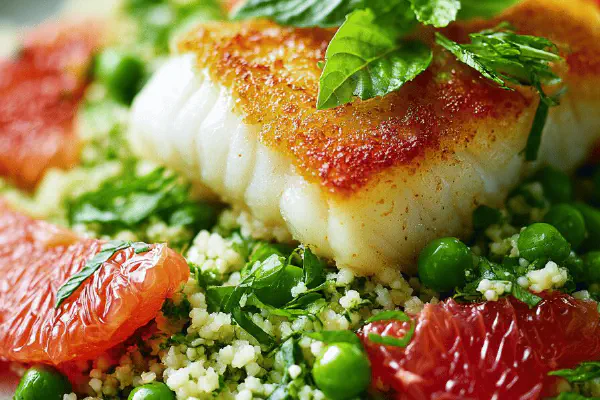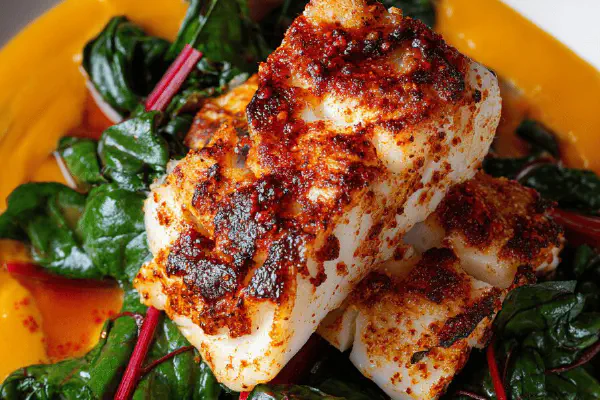Spiced Roast Fish with Carrot Purée
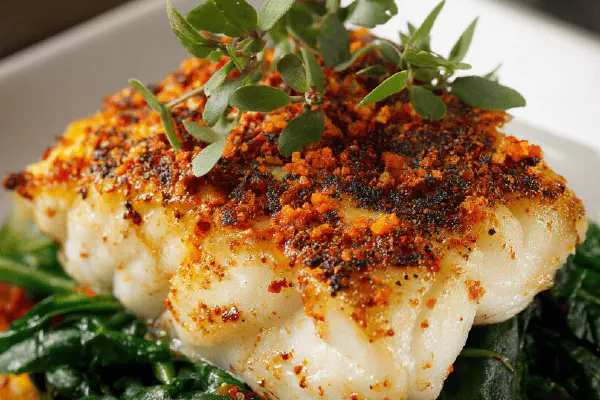
By Emma
Certified Culinary Professional
Ingredients
Purée de carottes
- 420 g (about 3 1/2 cups) carrots, sliced into rounds
- 1 celery stalk, finely chopped
- 1 small shallot, finely chopped
- 2 garlic cloves, minced
- 300 ml (1 1/4 cup) low sodium chicken broth or vegetable broth for vegan option
- 25 ml (1 1/2 tbsp) butter or vegan margarine
Poisson
- 14 ml (just under 1 tbsp) sweet smoked paprika
- 14 ml (just under 1 tbsp) granulated garlic powder
- 6 ml (1 1/4 tsp) brown sugar
- 6 ml (1 1/4 tsp) celery salt
- 1 pinch cayenne pepper (optional, adjust to taste)
- 650 g (1 1/3 lb) white fish fillets, skin removed or on, like cod or haddock, cut into 4 portions
- 225 g (approx 8 cups) Swiss chard leaves, blanched 3 minutes in salted boiling water
- Salt and freshly cracked black pepper
About the ingredients
Method
Purée de carottes
- 1. Get a medium pot. Toss in carrots, celery, shallot, garlic, and broth. Bring to a rolling boil. Then lower heat to medium-low and simmer gently. Carrots should yield easily to a fork in about 22 to 27 minutes. No rattling the test with a timer but by feel—the fork sinks without resistance.
- 2. Drain veggies (reserve a splash of broth if you need to loosen purée later). Transfer to a blender or use immersion blender. Purée until fully smooth—no fibrous bits. Add butter, stir or pulse a few seconds till melted in. Season with salt and pepper thoughtfully. Too salty? A splash more broth can balance. Keep warm on very low heat or cover tightly so it doesn’t dry out.
Poisson
- 3. While purée simmers, mix spices: paprika, granulated garlic powder, brown sugar, celery salt, and cayenne into one shallow dish. The sugar caramelizes nicely in the pan, creating a subtle crust. Taste the blend raw—too salty? Hold back celery salt slightly next time. Play with cayenne quantity; it’s there for warmth, not to dominate.
- 4. Press fish skin-side down if skin-on onto the spice mix firmly. Pat spices so they stick well, especially along edges. I find this grip prevents the crust from falling off during cooking. If skinless, apply evenly on one side, maybe a tiny sprinkle on back too.
- 5. Heat a heavy nonstick pan or cast-iron skillet over medium-high heat—wait till it’s just about smoking. Add butter or oil of choice—enough to coat bottom thinly. When bubbling but not smoking, gently lay fish spice-side down. You should hear an immediate sizzle, a crackle of searing flesh.
- 6. Let fish cook undisturbed for about 3 minutes or until edges turn opaque and start browning nicely. Flip carefully with a spatula. Cook the other side 3 minutes, maybe a bit more if fillets thick. The fish will flake under gentle pressure when done. Important: start spice side down to let sugars caramelize without scorching them.
- 7. Season lightly with salt and fresh cracked pepper now. Don’t overdo; chances are spices stocked plenty of salt already. Remove from pan onto warm plate, tent loosely with foil if waiting.
Assembly
- 8. Place carrot purée in the center of warmed plates. Spoon blanched Swiss chard evenly around or on top against purée for a wet-dry texture contrast. Gently lay spiced fish portions atop greens. Splash extra virgin olive oil or a squeeze of lemon for brightness, if you like.
- 9. Serve immediately. Fish will still retain some moisture, tender flakes. Watch for dryness—the crust burning means pan too hot or fillets left too long.
- Tips and variations: Swap fish for thinner fillets like sole, cut cooking time. Vegan version: use vegetable broth and vegan butter. Add a pinch smoked chili powder for flair. Chard can be replaced by spinach but blanch briefly to keep vibrant green. If purée too thick, whisk in reserved broth or a dab of cream if dairy is ok.
Cooking tips
Chef's notes
- 💡 Carrots take time; no rushing. Fork test—should slide in easy not mushy or firm. Timing varies by slice thickness. Broth splash handy if purée too thick; thin til just right. Butter melts in for richness or swap vegan margarine—texture shifts but stays creamy. Purée smooth means no stringy bits; immersion blender best for control. Keep warm low heat, cover tight or it dries fast.
- 💡 Paprika choice impacts taste sharp. Smoked paprika adds deep notes but watch not burn. Granulated garlic powder better than fresh here for crust texture. Press spice mix firmly on skin or fish surface. Skin on needs extra grip, holds crust during flips. Skinless easier but misses crisp contrast. Flip fish when edges turn opaque, slight crackle sound changes—key sensory clue. Overcooking kills moisture; fish flakes gently when ready.
- 💡 Swiss chard must be blanched short three minutes max. Color bright or limp bitterness shows. Salted boiling water critical; washes toughness. Drain well pat dry to avoid water cooling fish or purée. Swap spinach if needed; blanch less time though or leaves wilt instantly. Leaf texture vital for wet/dry contrast on plate. Place greens around carrot purée, then fish atop. Warm plates help keep everything at serving temp and flavors close.
- 💡 Butter or oil choice changes fat profile and flavor. Butter richer but browns faster, careful on temp. Olive oil safer at medium-high heat, no smoke. Vegan spreads okay but watch melt point. Pan hot but not smoking—hot enough for sizzle but don’t scorch sugar in spice mix; burns bitter fast. Spice crust caramelizes gently if heat balanced. Use spatula with care when flipping; fish delicate. Fish portions thinner cook faster—adjust accordingly.
- 💡 Spice salt balance tricky. Too much celery salt cloys; too little, flat. Brown sugar caramelizes slowly; white sugar flashes crust but less depth. Cayenne optional, add little. Chipotle powder swap for smokier heat but shifts flavor. Taste dry mix first if unsure. Purée too salty add broth splash, dilution helps instantly. If fish crust flakes, press firmer or chill fish before coating. Always have backup fish ready if batch overcooks or coating burns.
Common questions
How to know fish is done?
Look edges for opaque silvery change. Fish should flake lightly under gentle pressure. No jiggle, no raw spots. Sound shifts from sharp sizzle to soft crackle when ready. Timing rough—3 mins each side but thickness varies. Smell toasted spices too.
Broth substitution?
Chicken broth adds richness but vegetable broth works fine, especially vegan. Avoid powders or strong celery powders; fresh celery stalk better flavor balance. Stock low sodium if possible—salt control important. Water plus herb bundle okay for purée but less flavor depth.
Why is purée stringy sometimes?
Overcooked or under-blended carrots cause strings. Blending speed matters; slow pulse or immersion blender preferred. Rapid blender can whip air, change texture. Also size carrot slices; uneven pieces cook unevenly. Patience on simmer—soft to fork but not mushy. Reserve broth to loosen if pasty or thick too.
Storage tips?
Purée stores refrigerated covered tight 2-3 days; reheat gently stirring to prevent drying. Fish better fresh but leftovers can freeze in airtight container. Swiss chard wilts fast refrigerated—try to eat day of prep. Reheat fish briefly to avoid drying flakes. Olive oil drizzle before serving revives moisture.
